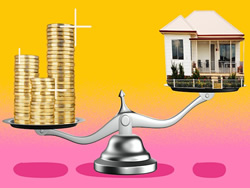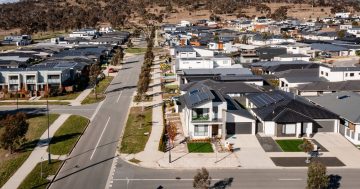Patrick Wright* discusses an important consideration for homeowners thinking about refinancing.
 As interest rates rise and everyday necessities become more expensive, it’s important to make sure you’re getting a good deal on your home loan.
As interest rates rise and everyday necessities become more expensive, it’s important to make sure you’re getting a good deal on your home loan.
Whether you’re in the market for your first home or looking to negotiate with your lender, it’s important to come armed with information.
One important concept is the “loan-to-value ratio” or LVR.
It’s a measure of the debt owed on a property compared to its value.
But how does LVR work? And how does it impact your repayments and ability to refinance?
How to calculate LVR
LVR is a measure of a property’s indebtedness.
It’s simple to calculate: all you need to do is divide your loan amount by your property’s value.
For example, if you have a home with a valuation of $600,000 and a $450,000 loan, the LVR will be 75 per cent.
“The lower the LVR, the less risk to the bank, and banks price to risk,” says Louisa Sanghera, a mortgage broker and former bank operations manager based in Sydney.
“So, if you’ve got a lower LVR, you’re going to get a cheaper deal.”
The discount available will depend on the lender, she adds.
Some lenders will offer the same rate for all loans below 80 per cent LVR, while others use a tiered pricing system.
“Some banks will offer one price for 95 per cent LVR and there may be a different price at 80 per cent, 70 per cent and 60 per cent,” Ms Sanghera says.
Importantly, the discounts for lower LVR loans can be very significant.
Ms Sanghera says a borrower with 60 per cent LVR may be eligible for a home loan half a percentage point cheaper than a 95 per cent LVR borrower.
“It doesn’t sound a lot to some people, but half a per cent is a lot of money — hundreds of dollars a month,” she says.
“Do you want that in your pocket? Or do you want the bank to have that money?”
What to know about lender’s mortgage insurance
Most lenders require borrowers to take out lender’s mortgage insurance (LMI) when they borrow at an LVR over 80 per cent.
LMI is a one-off non-refundable premium that’s added to your home loan.
The key thing to remember is that it’s insurance for the lender against default — it’s not insurance for you.
John Ng, a mortgage broker based in Melbourne’s western suburbs, says LMI can cost thousands to tens of thousands of dollars depending on the size of the loan.
“For most consumers out there, the idea of paying a premium or paying LMI doesn’t sit well with them,” he says.
But with the soaring property market of recent years, many borrowers have opted to pay LMI rather than wait for a 20 per cent deposit, which can take more than a decade to save.
One problem with taking out a high-LVR loan is that you may need to pay LMI again if you want to refinance.
“We always point out that if they ever want to refinance over 80 per cent LVR, they’re always going to have to pay lender’s mortgage insurance again, which a lot of people don’t think about,” Ms Sanghera says.
How changes in the property market affect your LVR
If you pay down your loan, or your property increases in value, your LVR will come down.
But as property prices fall — as they are in many parts of Australia now — LVRs will expand.
It’s bad news for first home buyers who bought during the red-hot markets of the pandemic, especially those without a sizeable deposit.
“I’m definitely seeing consumers out there who are already stuck in their current situation,” Mr Ng says.
“They fell into a state of complacency in the last few years, and they never thought rates would increase.
“They bought an extra car or spent way more than they should.”
If you’re shopping around for a new home loan, keep in mind that you might get different valuations from different lenders.
“Each bank will have a panel of valuers.
“You never know who you are going to get but the valuations should all be coming in at a similar price,” Ms Sanghera says.
But it doesn’t always work out like that.
“Generally, you’ll find that the valuations are pretty similar, but I’ve also found big differences, up to $50,000 to $70,000 in property value,” Mr Ng says.
“That $50,000 to $70,000 may be the difference between [a LVR of] under 80 per cent or over 80 per cent.”
Why it’s important to avoid ‘customer inertia’
While the property market has slowed down, many homes are still worth more than they were prior to the pandemic, Mr Ng says.
If that’s your situation, and you haven’t shopped around or re-negotiated your rate with your bank recently, you might be leaving money on the table.
“Don’t fall into that trap. You’ve got to keep the banks honest,” he says.
“Generally, a rate review every 18-24 months is the sweet spot.
“Refinancing is a hassle, you don’t want to be refinancing every month.”
This article contains general information only. You should consider obtaining independent professional advice in relation to your particular circumstances.
*Patrick Wright is a reporter for ABC Life.
This article first appeared at abc.net.au.











